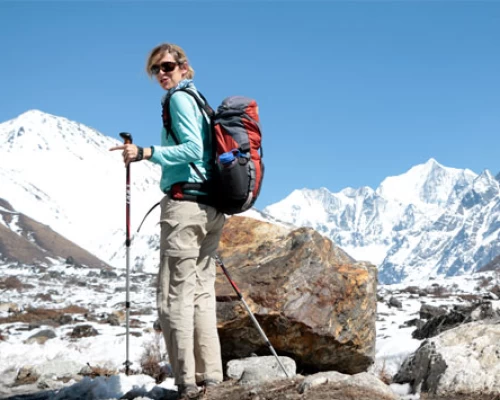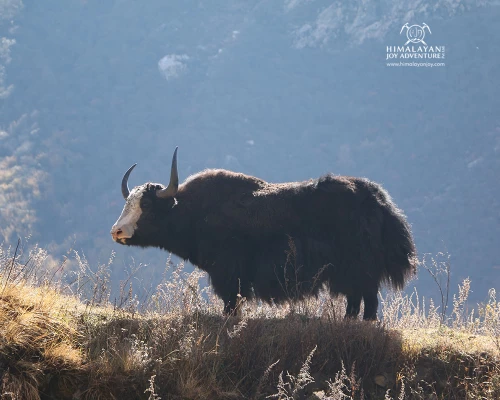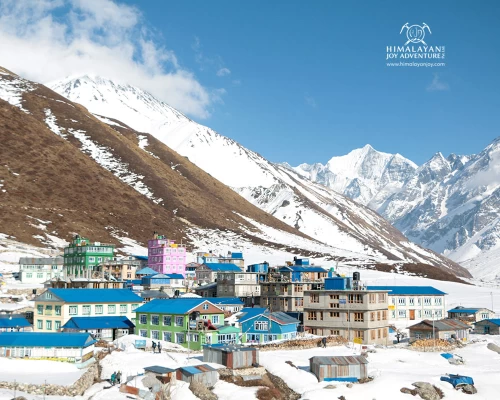Highlights
- The drive from Kathmandu to Syabrubesi is full of amazing views of green hills, farmlands, and snowy mountains, making it a great start to the trek.
- Visiting Langtang Village and Kyanjin Monastery gives you a chance to see local Tamang culture and learn about Buddhist traditions in a peaceful mountain area.
- Climbing to Kyanjin Ri offers stunning views of the Langtang mountains and nearby snowy peaks.
- The trek includes beautiful waterfalls, clear rivers, and fun suspension bridges that make the journey exciting.
- You can see the huge Lirung and Kimshung glaciers, which are amazing ice formations in the Himalayas.
- Old Buddhist monasteries, stupas, and monuments along the trail show the area's rich culture and history.
- At the cheese factory in Kyanjin Gompa, you can taste fresh yak cheese and see how it’s made.
- The trail takes you through forests and open meadows with colorful flowers and lovely views.
- You’ll get to see amazing mountains like Langtang Lirung, Dorje Lakpa, Kimshung, Gang Chhenpo, Naya Kanga, and Yansa Tsenji.
- Langtang National Park is full of animals like red pandas, snow leopards, bears, monkeys, and deer, making the trek even more exciting.
Langtang Valley Trek Overview
Langtang Valley Trek is one of the most popular and loved trekking routes in Nepal. It is located just south of the Tibetan border, in a narrow valley surrounded by tall Himalayan mountains to the north and slightly smaller snowy peaks to the south. In this beautiful area, Langtang Lirung (7,246m) stands tall in the north, while Gang Chhenpo (6,388m) and Naya Kanga Ri (5,846m) rise in the south, with Dorje Lakpa (6,966m) marking the eastern side of the valley. The trek takes you through one of Nepal’s remote and stunning regions, including the sacred Gosaikunda Lake and the peaceful Helambu Valley.
The 10 days Langtang Valley Trek itinerary with Himalayan Joy Adventure begins with a day in Kathmandu, followed by a journey to Syabrubesi on the third day. Syabrubesi, a small and charming Tamang town near the Bhote Koshi River, is the starting point of the trek.
The trail passes through green forests, open meadows, and small streams, with overnight stays in Tamang villages. These stops let trekkers experience the unique culture and traditions of the Tamang people, many of whom have Tibetan roots. This area was once an important trade route with Tibet, which adds to its cultural importance. The trek also takes you through Langtang National Park, where you might see wildlife and birds. The highest point of the trek is Kyanjin Gompa.
The trail then climbs to Kyanjin Gompa (3,830m), where you can visit the Yala Cheese Factory and explore the surrounding areas. Nearby, you can find small lakes and amazing views of the mountains. From Kyanjin Gompa, you can see glaciers that lead to Tibet.
The journey back follows the same route to Syabrubesi, taking two days, and then continues with a jeep ride back to Kathmandu. For those who want to extend their trek, there is an option to go through Syabru village, visit Sing Gompa, see the sacred Gosaikunda Lake, and cross the Laurebina Pass (4,610m). This extended trek continues into the Helambu valley and ends in Chisapani before returning to Kathmandu.
Known as the "hidden valley trek", the Langtang Valley Trek offers stunning natural beauty and a chance to experience the local culture, making it a perfect choice for nature lovers and adventure seekers.
Where is Langtang Valley located, and why is it unique?
You might be hearing a lot about Langtag Valley and be wondering where Langtang Valley exactly is. Langtang Valley is in central Nepal, about 80 kilometers north of Kathmandu, near the border with Tibet. The village was completely destroyed by the 2015 earthquake in Nepal. But now, it has been fully rebuilt, and the trails and village are restored. Langtang Valley is part of Langtang National Park, which is known for its beautiful views, amazing wildlife, and rich culture.
Unlike busy trekking routes like Everest Base Camp (EBC) or Annapurna Base Camp (ABC), the Langtang Valley Trek offers a different and unique experience. It is surrounded by tall Himalayan mountains like Langtang Lirung (7,246m) and has stunning views of glaciers, green forests, and peaceful meadows. The valley is also home to rare animals like red pandas, snow leopards, and Himalayan black bears.
The people living in Langtang, mostly from the Tamang community, follow a culture influenced by Tibet. You can see their traditional homes, visit old monasteries, and enjoy their warm hospitality.
Unlike treks like Mardi or Ghorepani, the Langtang Valley Trek doesn’t have long stone stairs, so you can enjoy a natural walking experience. Since it’s close to Kathmandu, it is a great choice for a short trek.
What is the difficulty level, and is it suitable for beginners?
TheLangtang Valley Trek is considered a moderate trek, which means it is not too easy but also not extremely hard. It is suitable for most people, including beginners who are in good health. The trek involves walking for about 5 to 7 hours each day on well-marked paths. Although the trail is not too difficult, there are some uphill sections and higher altitudes, which can be a bit challenging for people who are new to trekking or not used to walking at higher altitudes.
There are no technical climbing parts, so you don’t need any special skills, but the trek does include some steep areas and long walking days. The highest point of the trek is Kyanjin Gompa, at 3,830 meters, so you might feel a little short of breath or tired due to the altitude.
If you are a beginner, it’s a good idea to prepare by walking or hiking on similar trails before the trek. Staying hydrated, taking breaks, and keeping a positive attitude will also help. Overall, the Langtang Valley Trek is a great choice for beginners.
Langtang Valley Trek Cost in 2026
The cost of the Langtang Valley Trek in 2026 will generally range from USD $650 to $1,200 per person for a 10 days trek. The exact price can vary depending on factors such as the services included, the season of trekking, and the type of package you choose.
At Himalayan Joy Adventure, we offer a 10 days Langtang Valley Trek starting at USD $1,000 per person. Our prices vary depending on the size of the group. Please refer to the cost details in the table below.
| No of Pax | Starting price (Per Person) |
|---|---|
| 1-2 pax | USD $1000 |
| 3-5 pax | USD $950 |
| 6-10 pax | USD $850 |
| 11-15 pax | USD $750 |
| 16-20 pax | USD $650 |
If you have any inquiries regarding the trek's cost or itinerary, please feel free to contact us anytime.









